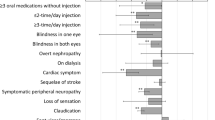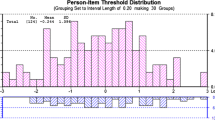Abstract
Objective: To assess patient preferences for health states associated with diabetic peripheral neuropathy (DPN).
Design and intervention: Seven health states describing varying stages of disease severity in DPN were developed: mild neuropathy, painful neuropathy, severe neuropathy, minor ulcer, severe ulcer, minor amputation and major amputation. Using a computer interview, both rating scale (RS) and standard gamble (SG) preference scores were elicited from 52 patients with diabetes mellitus.
Setting: A US university medical centre and a Veterans Affairs clinic.
Study participants: Adult patients with type 1 and type 2 diabetes mellitus between the ages of 18 and 80 years. Patients were excluded if they had been diagnosed with DPN.
Results: Preference scores decreased in accordance with greater symptomatic and functional impairment. Median RS scores ranged from 0.89 to 0.23 for the seven health states. Median SG scores ranged from 0.96 to 0.65.
Conclusions: Patient preferences for health states decrease as a function of increasing disease severity in DPN. The result is robust across the RS and SG methods of preference measurement. These results may be useful in informing policy analyses for resource allocation in patients with diabetes mellitus.




Similar content being viewed by others
References
Harris M, Eastman R, Cowie C. Symptoms of sensory neuropathy in adults with NIDDM in the US population. Diabetes Care 1993 Nov; 16 (11): 1446–52
Eastman RC. Neuropathy in diabetes. In: Harris MI, editor. Diabetes in America. 2nd ed. Washington (DC): US Govt Printing Office, 1995. Report No.: NIH publ. No. 95-1468: 339–48
Giannini C, Dyck PJ. Pathologic alterations in human diabetic polyneuropathy. In: Dyck PJ, Thomas PK, editors. Diabetic neuropathy. 2nd ed. Philadelphia (PA): WB Saunders Company, 1999
Carrington AL, Mawdsley SK, Morley M, et al. Psychological status of diabetic people with or without lower limb disability. Diabetes Res Clin Pract 1996 Apr; 32 (1–2): 19–25
Benbow SJ, Wallymahmed ME, MacFarlane IA. Diabetic peripheral neuropathy and quality of life. QJM 1998 Nov; 91 (11): 733–7
Brod M. Quality of life issues in patients with diabetes and lower extremity ulcers: patients and caregivers. Qual Life Res 1998 May; 7 (4): 365–72
Patrick D, Erickson P. Health status and health policy. New York: Oxford University Press, 1993
Drummond MF, O’Brien B, Stoddart GL, et al. Methods of the economic evaluation of health care programmes. 2nd ed. Oxford: Oxford University Press, 1997
Bardsley MJ, Astell S, McCallum A, et al. The performance of three measures of health status in an outpatient diabetes population. Diabet Med 1993 Aug–Sep; 10 (7): 619–26
Childs MR, Peters EJG, Armstrong DG, et al. What is the effect of amputations on the quality of life in diabetic patients? Diabetologia 1998; 41 Suppl. 1: A279
Holtzman J, Caldwell M, Walvatne C, et al. Long-term functional status and quality of life after lower extremity revascularization. J Vasc Surg 1999 Mar; 29 (3): 395–402
Eckman MH, Greenfield S, Mackey WC, et al. Foot infections in diabetic patients. JAMA 1995 Mar 1; 273 (9): 712–20
Brown GC, Brown MM, Sharm S, et al. Quality of life associated with diabetes mellitus in an adult population. J Diabetes Complications 2000 Jan–Feb; 14 (1): 18–24
Hux M, Milkovich N, Torrance G, et al. Health-related quality of life related to chronic foot ulcers in diabetics [abstract]. Qual Life Res 1999; 8: 655
Tennvall GR, Apelqvist J. Health-related quality of life in patients with diabetes mellitus and foot ulcers. J Diabetes Complications 2000 Sep–Oct; 14 (5): 235–41
Gold MR, Siegel JE, Russell LB, et al. Cost-effectiveness in health and medicine. New York: Oxford University Press, 1996
Sumner W, Nease R, Littenberg B. U-titer: a utility assessment tool. Proceedings of the Fifteenth Annual Symposium on Computer Applications in Medical Care; 1991: 701–5
Jr Nease RF, Tsai R, Hynes LM, et al. Automated utility assessment of global health. Qual Life Res 1996 Feb; 5 (1): 175–82
Jr Nease RF, Kneeland T, O’Connor GT, et al. Variation in patient utilities for outcomes of the management of chronic stable angina. JAMA 1995 Apr 19; 273 (15): 1185–90
Merlino L, Bagchi I, Taylor T, et al. Reference values for corticosteroid-associated adverse health states in 107 rheumatoid arthritis patients [abstract]. Med Decis Making 1998 Oct–Dec; 18 (4): 470
Tosteson ANA, Gabriel SE, Kneeland TS, et al. Impact of hormone replacement therapy (HRT) on quality of life [abstract]. Med Decis Making 1997 Oct–Dec; 17 (4): 532
Froberg DG, Kane RL. Methodology for measuring health state preferences: II. scaling methods. J Clin Epidemiol 1989; 42 (5): 459–71
Bass EB, Steinberg EP, Pitt HA, et al. Comparison of the rating scale and standard gamble in measuring patient preferences for outcomes of gallstone disease. Med Decis Making 1994 Oct–Dec; 14 (4): 307–14
National Institute for Clinical Excellence. Technical guidance for manufacturers and sponsors on making a submission to a technology appraisal. Issue date:March 2001. Available from URL: http://server2.nice.org.uk/pdf/technicalguidanceformanufacturersandsponsors.pdf [Accessed 2001 Aug 13]
Nord E. Methods for quality adjustment of life years. Soc Sci Med 1992; 34 (5): 559–69
Acknowledgements
The authors wish to acknowledge Darren Augenstein and Louis Garrison, Jr. for their help in the design and analysis of the study. Financial support for this study was provided in part by a contract from Roche Pharmaceuticals. The funding agreement ensured the authors’ independence in designing the study, interpreting the data, writing and publishing the report. At the time of the study, the following authors were completing a post-doctoral fellowship sponsored by Roche and administered by the University of Washington: Doris P. Lew, E. Beth Devine and David L. Veenstra.
Author information
Authors and Affiliations
Corresponding author
Rights and permissions
About this article
Cite this article
Sullivan, S.D., Lew, D.P., Devine, E.B. et al. Health State Preference Assessment in Diabetic Peripheral Neuropathy. Pharmacoeconomics 20, 1079–1089 (2002). https://doi.org/10.2165/00019053-200220150-00004
Published:
Issue Date:
DOI: https://doi.org/10.2165/00019053-200220150-00004




